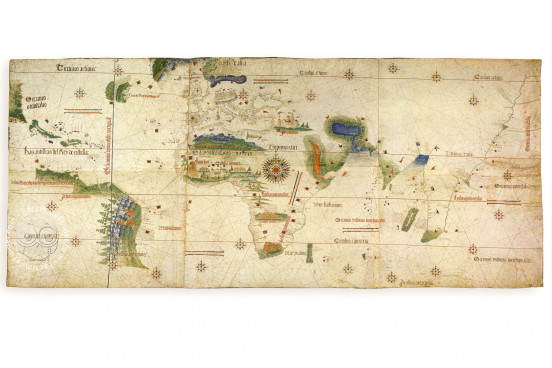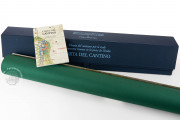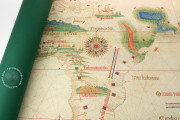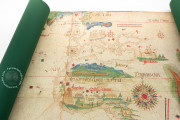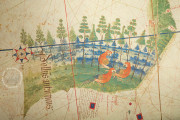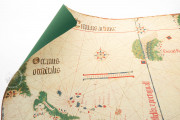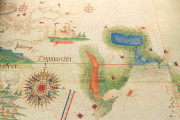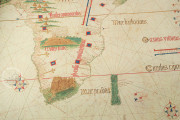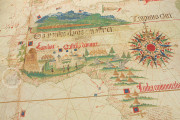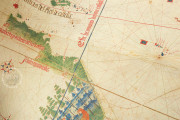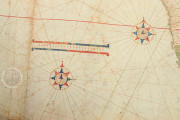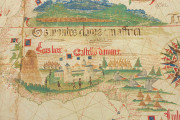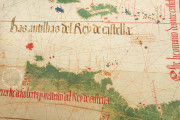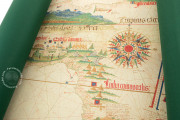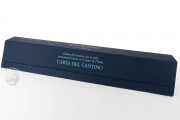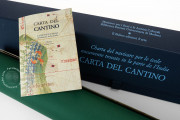The Cantino Map, also known as the Cantino Planisphere, is an outstanding example of European Renaissance cartography remarkable for its blending of aspects of traditional portolan nautical cartography with mapmaking according to astronomical navigation. Made in Portugal in 1502, the map is named for Alberto Cantino, who paid a handsome sum for it and smuggled it out of the country to the court of Ercole I, Duke of Ferrara, Modena, and Reggio. It shows the most recent geographical discoveries of its time.
The map's graphic features and Portuguese-language inscriptions, written in red and black, convey the historical, geographical, and political situation of the world known to Europeans. The Mediterranean basin and the Caribbean are drawn as on portolan charts by magnetic north and estimated distances between points on the coasts, whereas Africa, Brazil, and India are plotted according to their latitudes.
A Map of Great Visual Interest
The map features a large compass rose in blue, green, ocher, and red with a delicately drawn face in its central circle and two fleur-de-lis marking north, smaller compass roses, and a network of rhumb lines, all traditional elements of portolan charts. Also time-honored—based on the custom of mapmaking according to the ancient Roman scientist Ptolemy—is the red coloring of the Red Sea.
The Cantino Map pictures groves of trees and three large multicolored birds on the coast of Brazil. Groups of birds are also pictured in Africa, green ones along the western coast of North Africa and grey ones with red tails near the large compass rose.
There is an arresting bird's-eye-view of Elmina Castle, the first trading post built on the coast of the Gulf of Guinea. Portuguese flags fly from its towers, and silhouettes of indigenous people surround it, the only depictions of humans on the map. Views of Venice and Jerusalem show characteristic features of those cities, and the Tower of Babel finds a place in North Africa.
The Most Up-to-Date World Map of its Time
The map reflects the Portuguese voyages and discoveries of the turn of the sixteenth century and represents the most current information in Europe concerning the Americas and the East (mainly India): Pedro Alvares Cabral reached Brazil on April 22, 1500—only two years before the map was drawn—and Vasco da Gama returned from India in 1499.
The map benefits from knowledge of south Atlantic islands first imparted by João da Nova on his return to Lisbon in September 1502. Indeed, because of the political importance of the newest discoveries, at the time the map was made, there was a royal prohibition on the dissemination of maps and globes depicting the newly discovered lands.
The polity of the Americas is indicated by a blue vertical line showing the division of the new discoveries between Portugal and Castile according to the Treaty of Tordesillas, signed in 1494.
A Spy with a Mission
Alberto Cantino, envoy of the Duke of Ferrara to the royal court of Portugal, seems to have been intent on securing a map disclosing recent geographic discoveries. He wrote to the duke regularly from Spain and Portugal describing the riches being brought from the exploratory voyages of the time, and he paid twelve gold ducats for the map.
The map remained in Este hands and was eventually transferred to Modena in 1598 in accord with the Convention of Faenza, which returned Ferrara to the Papal States. The Este library was installed in the Palazzo Ducale in Modena in 1696. The Cantino Map was stolen in 1859 and then returned to the library through the offices of Giuseppe Boni. Upon the unification of Italy in 1871, the library became the Biblioteca Estense Universitaria.
We have 1 facsimile edition of the manuscript "Cantino Map": La Carta del Cantino facsimile edition, published by Il Bulino, edizioni d'arte, 2004
Request Info / Price
